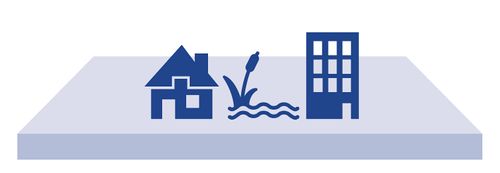Layer 2- Spatial adaptation
What is layer 2?
Layer 2 of the Multi-Layered safety concept is the layer of spatial adaptation, and refers to all types of spatial solutions measures (to be) taken to decrease the loss due to flooding.
What measures can you take in this layer?
Measures that you can take in this layer are related to
- Natural Flood Management or NFM, considers the hydrological processes across the whole catchment of a river or along a stretch of coast to identify where measures can best be applied, with a focus on increasing water retention capacities (EU, 2019). Examples of such measures are:
- Restoring natural flows by realignment of coastal areas, or re-connection of rivers with their floodplain.
- Restoration of wetlands which can store flood water and help “slow the flow” of flood waters.
- Reservoirs in agricultural areas which can store flood water during flood events, and otherwise be high nature value areas.
- Urban Green Infrastructure such as green spaces, sustainable urban drainage and green roofs."
- Flood proof zoning measures are preventive measures taken to reduce consequences and damage of flood events by keeping water away from people and flood prone areas. Preventive measures require proactive spatial planning and flood-proof spatial design. Proactive spatial planning refers to removal of measures or relocation of construction in flood prone areas and appropriate land use (flood risk modeling, assessment, flood risk zoning). Flood-proof spatial design implies the adaptation of existing and future constructions (adjustments of existing houses and infrastructure).
- Critical infrastructure is the physical and information technology facilities, networks, services and assets that, if disrupted or destroyed, would have a serious impact on the health, safety, security or economic well-being of citizens or the effective functioning of governments in EU States. Critical infrastructures extend across many sectors of the economy, including banking and finance, transport and distribution, energy, utilities, health, food supply and communications, as well as key government services (COM, 2004).
What tools are available in this layer?
FRAMES has compiled a list of tools used and classified these per layer. Click here to find out what tools are available for layer 2.

